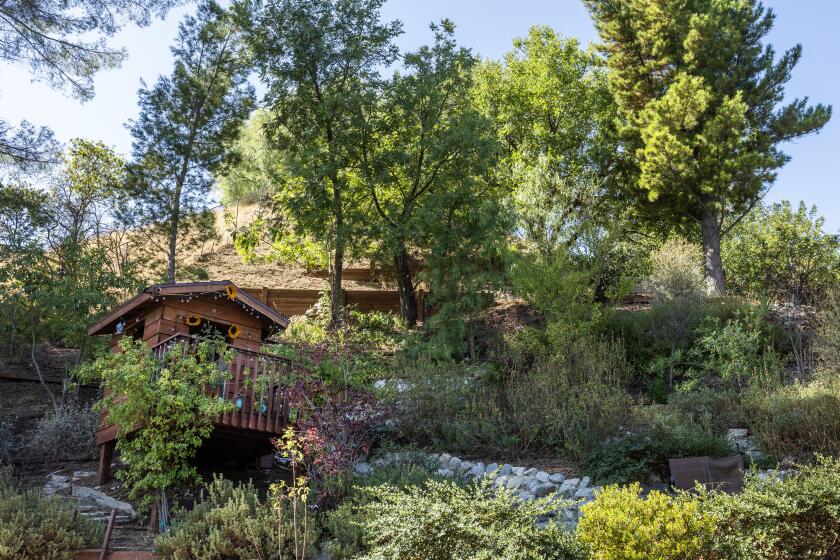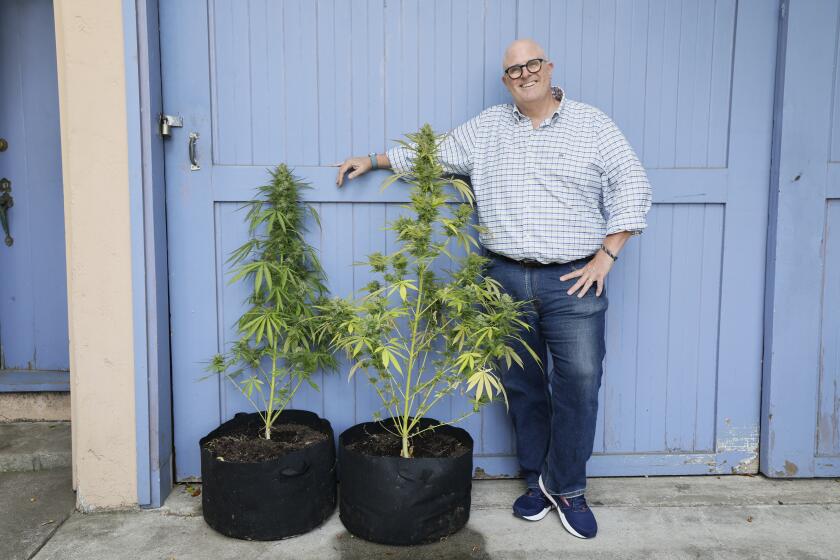While Weather Is Mild, Plant Perennials
Despite the weird weather--which was cool all summer, causing some things to bloom early, and then suddenly turning very hot last weekend, finishing off a few more blooms--I still have perennials in full flower, which is what makes them such remarkable plants. And, if the earth stands still and the weather continues mild, this looks like the weekend to do something with perennials.
Plant some, for instance. The fall months are perhaps the best, if not the most dramatic, time to plant perennials in Southern California. Right now, as the flowers finish up or as the plant begins to wither or go dormant, the opposite is occurring just beneath the soil.
Dig up a perennial right now and you will most likely find that it has made a goodly number of new shoots. These will not break through the ground until early spring (usually late January or early February), but they are making ready right now.
This means any perennial planted now will be good and ready for that tremendous spurt of spring growth, more than if you wait until spring to get started. As a result, they will flower better, earlier and longer.
In my experience, you can plant perennials at just about any season, even summer if you are careful to keep them watered, but for spectacular results you can’t beat fall planting. It is also a lot easier to care for them because they will be getting settled in their new surroundings during the cooler, hopefully rainier, time of the year.
Spring Planting Is Dramatic
It’s true that planting in spring is more dramatic because perennials immediately begin to grow and flower, but you won’t get the same kind of show you will if you plant now.
The only trouble with this rationale is that perennials are darned hard to find at this time of the year. Nurseries, realizing that it is much easier to sell a plant in flower, prefer to spotlight their perennials in spring and summer, when they are flowering. At this time of the year, they hide the remaining stock behind the lath house, because it is going dormant, or semi-so.
There is help for the determined fall planter. Several nurseries now specialize in perennials, and they are not so quick to put them out of sight. One is even hosting an event today, from 9 a.m. to 4 p.m., to spotlight perennials.
Palos Verdes Begonia Farm, which is not just a begonia nursery, has invited representatives from two of the larger and more adventuresome wholesale growers of perennials, Magic Growers and El Modeno Gardens, to be on hand to answer questions. And, you can be sure that the perennials will be right out front. The nursery is located at 4111 242nd St. in the Walteria section of Torrance. Phone: (213) 378-2228.
Other nurseries in the Los Angeles area that I know specialize in perennials include Sperling in Calabasas, Sassafras in Topanga, Burkard in Pasadena, Desert-to-Jungle in Montebello and Roger’s Gardens in Corona del Mar. All should have a good stock, even at this time of the year.
Two Questions
If you are not familiar with perennials (plants that last longer than a season but not as long as a shrub), there are two questions to ask before you leave the nursery: Does it need sun or shade and how big does it get? The latter is especially important and big includes how wide. The perennial problem in my own garden is that the perennials keep getting bigger than I expected, in height and width, and things always look a trifle crowded if not downright congested.
In my opinion, all perennials like the same kind of soil--very good--and take similar culture--not too much water, but not dry either. If the weather is cool enough this weekend, take the time to thoroughly prepare the soil by lavishing amendments on it (see this column for the week of Sept. 26 for a detailed explanation of soil preparation). Get the soil right before planting, even if it means letting your new plants sit in their nursery containers for another weekend.
After you have planted them, don’t expect much until spring. They will just sit there, but they are growing new roots and shoots underground; be patient and keep them watered.
There are two brand-new perennials that you won’t be able to plant this fall, but might want to order and save room for. One is causing a tremendous stir among those adventuresome gardeners who will try to grow anything. It is a new series of hybrid Oriental poppies, those tall perennial poppies with the spectacular salad-plate-size flowers that look like tissue.
The Oriental poppies that have been available in the past are next to impossible to grow here (they need a cold winter), but these--called Minicaps--are the result of a cross between a perennial California poppy, Papaver californicum , and an Oriental poppy, developed here in California. The name Minicaps refers to another improvement--small seed capsules that are completely hidden by the flower’s stamens.
Many Colors Available
I don’t know anyone who has grown them yet, but I have already sent off an order. They are available from their originator, Mohn’s, P.O. Box 2301, Atascadero, Calif. 93423, for $3.50 a pop, plus shipping ($1.50 per plant), but first send for their catalogue which shows the many available colors and heights.
Also watch the seed catalogues that should be arriving in a month. One of the All-America Selections winners for 1988 is a perennial--a neat, compact Shasta daisy named “Snow Lady,” which only grows to a foot tall and has simple, old-fashioned white daisy flowers. I plan to save a few front row seats in my garden for this one.
Don’t Rush
You can also begin tidying up, cutting back or dividing perennials, but don’t be in too big a hurry. You have all fall and winter to do this pleasant task, and some perennials are still looking great or are coming back for another, fall bloom. In fact, make a note of what is flowering now, because these plants help bring color to the garden at a time of year when it is not otherwise plentiful.
In my garden, this includes the pink and white Japanese anemones, orange lion’s tail, purple perennial veronicas, the bright red native California fuchsia, and the indefatigable pink pentas.



